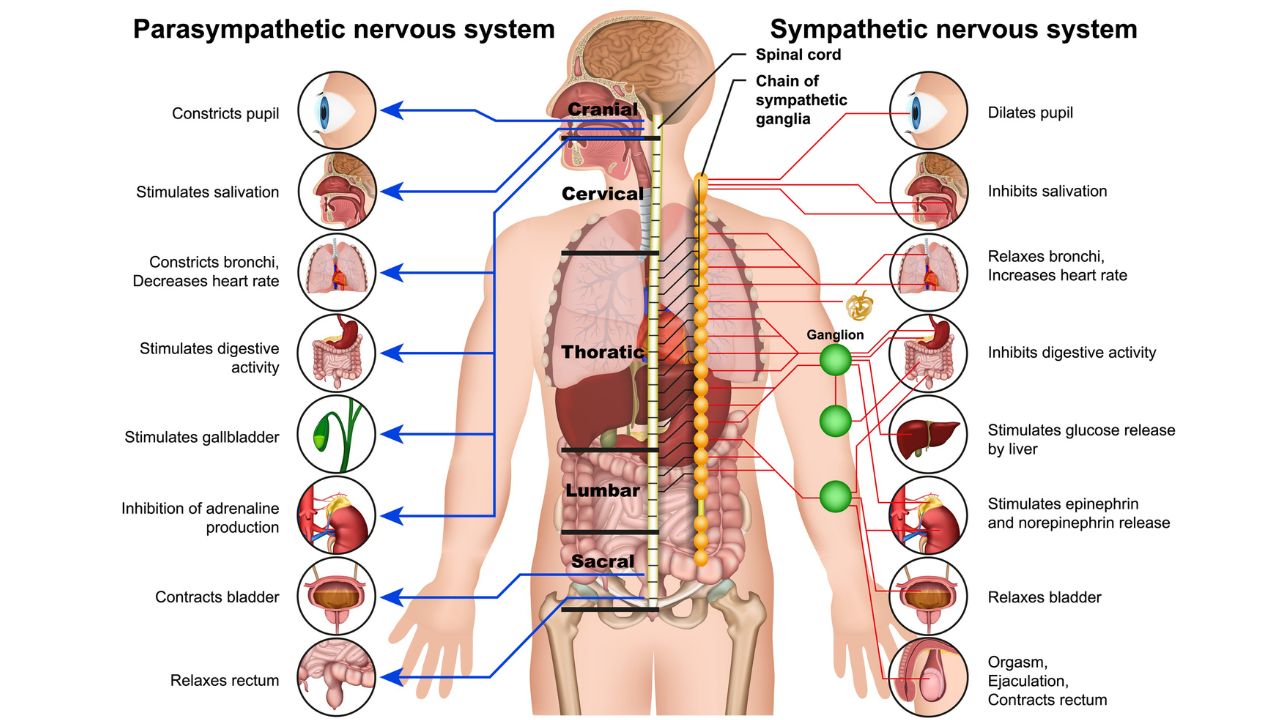Benefits of Vagus Nerve Exercises & 7 Simple Practices

FAQ on Vagal Nerve Exercises
1. What is the vagal nerve? The vagal nerve, often referred to as the vagus nerve, is the longest cranial nerve that runs from the brainstem to the abdomen, passing through various organs such as the heart and lungs. It plays a pivotal role in controlling the parasympathetic nervous system, which regulates body rest and digestion.
2. Why are vagal nerve exercises important? Vagal nerve exercises can help stimulate the vagus nerve, which can offer numerous benefits like reducing anxiety, improving gut health, and promoting overall well-being.
3. What are some common vagus nerve exercises? Vagus nerve exercises are practices that help activate or stimulate the vagal nerve. Common exercises include deep breathing techniques, humming or singing, gargling with water, and cold exposure, like cold showers.
4. How do I do vagal nerve exercises? For deep breathing, you'd inhale deeply, hold the breath momentarily, and exhale slowly. Humming or singing can be done at any comfortable pitch. For gargling, simply take a sip of water and gargle at the back of your throat for several seconds.
5. How often should I practice vagus nerve exercises? Consistency is key. Ideally, integrating one or more of these exercises into your daily routine can provide the best results. For instance, you might practice deep breathing for a few minutes each day.
6. Are vagal nerve exercises safe? Yes, vagus nerve exercises like deep breathing, humming, and gargling are generally safe for most individuals. However, always consult with a healthcare professional before starting any new exercise or health regimen.
7. How can vagus nerve exercises benefit my mental health? Stimulating the vagus nerve can help activate the parasympathetic nervous system, often referred to as the "rest and digest" system. This can lead to decreased stress, anxiety, and improved mood.
8. Are there any side effects of vagal nerve exercises? For the majority, these exercises are safe and don't produce adverse side effects. However, if you experience any discomfort or unusual symptoms, discontinue the exercise and consult a medical professional.
9. What is the difference between the terms 'vagal nerve' and 'vagus nerve'? Both terms refer to the same nerve, with 'vagus' being the more commonly used terminology. In this context, "vagal" and "vagus" can be used interchangeably when discussing exercises.
10. Are there any other ways to stimulate the vagus nerve? Yes, other methods to stimulate the vagus nerve include acupuncture, laughter, and yoga.
Why exercise the vagal nerve?
Vagus nerve exercises are activities focused on improving the health and functioning of the vagus nerve, a key component of the parasympathetic nervous system.
The vagus is an elongated cranial nerve that connects the brain with every major organ in the body, such as the heart, lungs, and digestive area.
Not only does it regulate key functions such as digestion, heart rate, sweating, speech and taste, but it also plays an important role in regulating our moods by helping us to relax after a stressful event.
Engaging in regular vagus nerve exercises like vagal nerve toning can help regulate the nerve's function and keep you feeling balanced!
Unfortunately, the vagus nerve can become damaged or dysfunctional due to age or chronic stress, leading to increased symptoms of depression or anxiety.
But there is good news!
Recent studies have revealed that there are various "stimulate vagus nerve" exercises which can help reduce stress while improving overall well-being. These vagus nerve exercises include sound based vagal toning, deep breathing, mindfulness meditation, yoga, and cold therapy.
Exercises that activate the vagus nerve have been shown to be effective in treating stress.
These exercises stimulate the vagus nerve, which helps regulate various body processes and can provide a calming effect.
Examples of these exercises include:
- Humming and singing
- Deep and slow breathing
- Mindfulness Meditation
- Chanting mantras or prayers
- Playing instruments
- Yoga
- Tai chi and qigong
Exciting research has shown the potential benefits of vagus nerve stimulation, indicating its role in the regulation of many bodily functions.
Stimulating your vagus nerve is surprisingly simple and can be done right at home.
Knowing how to do these exercises correctly may help you find relief from a variety of ailments and improve your overall health.
What are vagus nerves?

Actually the vagus is just one long and intricate nerve.
It’s the longest nerve in the body and plays an important role in maintaining a balance between stress and calm in the body.
This nerve begins at the base of your brainstem and travels through your body, connecting to vital organs along its path. It acts like a thermostat, automatically kicking in when needed to keep things running smoothly.
Your vagus nerve works with both the sympathetic and parasympathetic systems to regulate processes such as:
- Blood sugar levels
- Inflammation
- Free radicals
- Oxygen levels
- Chemicals which induce stress or calmness
It can be thought of like a neurochemical 'superhighway', carrying signals from the brain to the different limbs and organs of your body.
To ensure that your body is able to remain in a calm state and benefit from healing, it's beneficial to pursue activities which aim to stimulate the vagus nerve - known generically as "vagus nerve exercises".
These can range from breathing and mindfulness techniques to singing, humming or gargling specific sounds. A diagram showing the pathway of the vagus nerve through the body is shown below.

The vagus nerve and anxiety
The vagus nerve is part of the autonomic nervous system, which helps control the body's response to stress and danger. The sympathetic nervous system triggers the 'fight or flight' reaction, while the parasympathetic nervous system is responsible for switching our bodies into 'rest and digest mode.'
In order to help transition from a state of alertness to relaxation, vagus nerve exercises can be used. A 2018 study found that people with powerful vagal nerve activity are more able to recover quickly after a stressful situation.
Practicing certain breathing techniques and activating your voice through singing and humming are great ways to give your vagus nerve some exercise! Vagus nerve exercises are essential for regulating your body's fear response and calming the mind.

Of particular importance is managing your exposure to stress hormones like cortisol, which, when left unchecked, can increase your risk of developing:
- Heart-related issues
- Hypertension
- Digestive problems
- Weight gain
- Insomnia
- Anxiety
- Depression
Practicing targeted exercises to strengthen the vagus nerve can help you avoid the physical and mental exhaustion that can come with prolonged anxiety.
How Much Better Could You Be Feeling?
✨Find out with Sound Solution Guided Audio and Video Collection
Discover how healing with sound can easily restore wellbeing and peace of mind—in minutes.
Get lifetime access to a potent collection videos, audios of to erase stress, silence racing thoughts and restore your peace of mind in minutes.
Seven Vagus Nerve Exercises
1. Vagal Nerve Humming
Vagus nerve exercises can be incredibly helpful in maintaining a healthy nervous system and reducing stress. “Vagal Nerve Humming” is a simple technique that can offer you some great benefits that you can feel within 60-120 seconds!
To do it, place the palm of your hand on top of your head and inhale a full breath. As you exhale, make the sound of an "M" while closing your teeth together at the back.
Repeat this 4-8 times, noticing any physical or emotional changes that take place as you do it.
You may notice a buzzing sensation in your head from the vibration, increased mental clarity, feelings of peacefulness or relaxation and even energy simultaneously.
If you don't feel anything after trying this exercise, try increasing vocal volume, doing more repetitions or turning off external distractions so you can focus all your attention on the feeling of the vibration as you make the sound.
Here’s one of my best guided vagus nerve exercises:
2. Square Breathing for the Vagus Nerve
Do you feel anxious or overwhelmed? Vagus nerve exercises can help reduce these symptoms. One such exercise is square breathing, which helps activate your parasympathetic nervous system.
To practice:
- Start by exhaling all the air in your lungs.
- Then, slowly inhale for a count of four
- hold your breath for a count of four
- slowly exhale for another count of four
- and finally, wait for another count of four before starting the cycle again with an inhalation as you count to four.
If you have limited lung capacity, try using fewer seconds during each part of the exercise
Repeat this three to five times, or until calm.
According to a 2021 study, this type of deep and slow breathing for just five minutes helps promote a balance between sympathetic and parasympathetic nervous system activities and reduces anxiety levels.
3. Cold Water Exposure
Another category of exercises that can help to stimulate the vagus nerve and improve vagal tone involve cold water exposure.
According to research, one of the ways you can exercise your vagus nerve is by applying cold stimulation to the neck area. This can help slow your heart rate and direct more blood flow to your brain—which can potentially reduce levels of stress.
One such exercise involves splashing the face or taking a shower with cold water. This ancient Chinese practice has been found to be effective at reducing stress and sympathetic responses.
To do this exercise, try splashing water on your face 3-10 times or gradually turn on colder water in the shower.
Never shock your body by turning on cold water too fast. Always listen to your body and do what feels most comfortable to you.
For added skin stimulation, placing a cold pack onto your chest could further strengthen vagal tone.
4. Cardio Exercise
Even short workouts can help keep your vagus nerve healthy and strong.
A 2016 study found that just one session of cardiovascular exercise (like brisk walking) can increase vagus nerve activity.
Other forms of exercise to consider include cycling, strength training, swimming, and yoga.
However, be mindful of your limits when exercising and incorporate breath work and cooldowns into your workouts and take regular rest days. Working out too much can add stress to your body, so it is important to listen to your body's limits!
5. Hang Out with Your Pet
Practices that induce calm, such as spending time with animals, have been linked to improved heart rate variability---a sign of vagus nerve health. According to a 2019 study conducted by the Journal of American Psychiatric Nurses Association, animals have a positive effect on both mood and HRV. This data was seconded by a study from the International Journal of Environmental Research and Public Health which showed similar results.
6. Surround Yourself in Beauty
An easy and enjoyable exercise that helps to increase vagal tone involves adding something aesthetically pleasing to your day such as:
- taking a sunrise or sunset walk
- gazing at art and nature
- watching nature videos
- listening to nature sounds
These simple activities have been found to generate a positive state of mind which in turn helps to activate the vagus nerve and stimulate its activities.
7. Sing
Vagus Nerve exercises such as singing, humming or even belting out your three favorite songs can help to stimulate the vagus nerve near your vocal cords. This stimulation can lead to better mental and physical health, even if you are not carrying a tune in a bucket! Spending three minutes per day humming and singing your favorite songs will release feel-good hormones and activate your vagus nerve. Singing with others amplifies this effect. Connecting socially with others benefits the health of your vagus nerve and your overall well being by activating the bonding hormone oxytocin while also all the benefits of vagus nerve stimulation.
The health benefits of vagus nerve exercises
Vagus nerve exercises are a great way to improve your physical and mental health by stimulating the production of hormones that make you feel relaxed.
Among the best are sound-based practices like humming, chanting and singing which have been shown to:
- Reduce pain
- Foster improved nervous system function
- Elevate moods
- Lower blood pressure
- Decrease stress levels
- Regulate sleep cycles
- Decrease anxiety
Additionally, by participating in these exercises regularly you may reinforce your vagal tone - an indicator of emotional resilience in difficult times - thus potentially improving your overall wellbeing.
Vagus nerve exercises have been gaining traction in recent years due to the myriad of potential benefits they may offer.
Let's take a look at some recent research.
Mood and vagus nerve stimulation
A 2018 study published in Frontiers in Psychiatry has shown that regular vagus nerve stimulation can result in remission rates of 17% after three months and 33% after one year for those suffering from depression.
Brain Protection
Studies have further demonstrated that engaging in vagus nerve exercises can increase neurogenesis (formation of new brain cells) in the hippocampus, which is associated with learning and memory.
Blood pressure regulation
A study published in the Journal of Traditional and Complementary Medicine revealed that participants who regularly performed a vagus nerve stimulation technique had an 81% reduction in stress-induced blood pressure changes, while also experiencing significantly lower diastolic blood pressure numbers.
Reduced Inflammation
Exercises like deep breathing, mindful meditation and yoga, which activate the vagus nerve, can be beneficial for reducing inflammation in the body.
A 2018 review suggested that a strong activity of the vagus nerve is associated with better management of inflammation and a reduced risk of inflammatory diseases.
Therefore, stimulating the vagus nerve may help to treat conditions that are related to inflammation, such as rheumatoid arthritis and inflammatory bowel disease.
Today’s takeaway:
The vagus nerve plays an important role in the autonomic nervous system, regulating the body’s shift from fight-or-flight mode to a state of rest and digestion.
Because it is involved in many aspects of physical and mental health, exercising the vagus nerve can help improve well-being.
Exercises to activate this nerve may not be appropriate for everyone, however. Always check with your doctor before trying new exercises.
If they do not seem to be helping, it may be beneficial to discuss alternative strategies with a therapist or other medical professional.
Not sure where to start?
✨Try Jim's Sound Solution Guided Audio and Video Collection
Discover how healing with sound can easily restore wellbeing and peace of mind—in minutes.
Get lifetime access to a potent collection videos, audios of to erase stress, silence racing thoughts and restore your peace of mind in minutes.
Recommended: Our post popular posts
Healing the Body with Frequencies: The Basics Explained
Stimulating the Vagus Nerve for Better Sleep, Stress Relief & Health
Rain Sounds For Sleep, Rest Easy With Nature
Music Healing for Stress, Anxiety and Pain
Benefits of Vagus Nerve Exercises & 7 Simple Practices
The Five Longevity Secrets of “SuperAgers”
Vagus Nerve Exercises for Stress and Anxiety Relief
FDA Compliance: The information on this website has not been evaluated by the Food & Drug Administration or any other medical body.
We do not aim to diagnose, treat, cure or prevent any illness or disease. Information is shared for educational purposes only. You must consult your doctor before acting on any content on this website, especially if you are pregnant, nursing, taking medication, or have a medical condition.
The material provided on this site is for educational purposes only and any recommendations are not intended to replace the advice of your physician. You are encouraged to seek advice from a competent medical professional regarding the applicability of any recommendations with regard to your symptoms or condition.
Copyright © 2025 by Blue Beat Media, All Rights Reserved
Thank you for your interest in Jim Donovan / Jim Donovan Music.
We do not allow republication of our full newsletters and articles. However, you can post a portion (no more than 90 words, 1-2 paragraphs) of our content with a live link back to our homepage, donovanhealth.com, or a link to the specific article you are quoting from.
About the author:
Jim Donovan M.Ed. is a multi-platinum musician, educator and TEDx speaker.
His mission is to share the restorative power of music through education and performance.
Donovan is an Assistant Professor and Director of Music and Wellness at Saint Francis University.
His viral TEDx Talk "How to Trick Your Brain Into Falling Asleep" has been viewed over 6 million times to date.
He currently performs with his band The Sun King Warriors who can best be described as a blend of rhythm heavy roots rock, with a strong dose of big barreling drums.
Jim Donovan got his start as a founding member of the multi-platinum selling band Rusted Root.
There he co-wrote the song “Send Me on My Way” featured in the movies "Ice Age", "Matilda" and the Netflix series "New Girl".
During his time with the band 1990-2005, he recorded and released seven full length albums. Including "When I Woke" (3x platinum).
He also had the honor of sharing the stage with many of his musical influences and heroes including Robert Plant and Jimmy Page of Led Zeppelin (1995 US/UK tour), Carlos Santana (1997/2002 US tour), The Allman Brothers Band (1995/96 US tour), The Grateful Dead (1995 Three Rivers Stadium in Pittsburgh, PA) and many others.
Send Me On My Way also became the first song on Mars where it “woke up” NASA’s Mars Rover.




